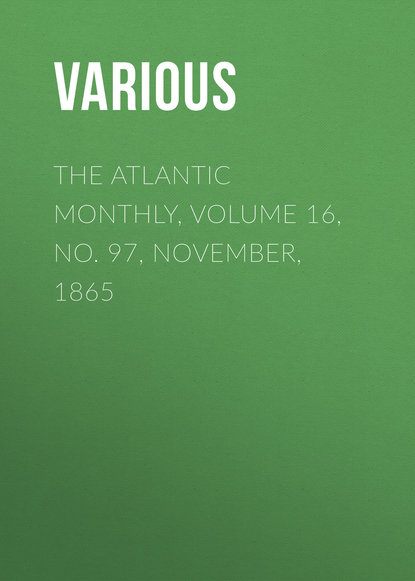 Полная версия
Полная версияПолная версия:
The Atlantic Monthly, Volume 16, No. 97, November, 1865
This line, which was projected by Perry McDonough Collins, Esq., United States Commercial Agent for the Amoor River, with its extension by the Russian Government to Irkoutsk, is the link now wanted to supply direct and unbroken telegraphic communication from Cape Race, in Newfoundland, on the eastern coast of America, across the Western Continent, the Pacific Ocean, and the Eastern Continent, to Cape Clear, in Ireland, the westernmost projection of Europe; and when a submarine cable shall be successfully laid between Cape Clear and Cape Race, will complete a telegraphic circuit around the earth between the parallels of forty-two and sixty-five degrees of north latitude.
The chief difficulties to be anticipated in Mr. Collins's enterprise are the extent of the territory to be traversed, its wild and rugged surface formation, and the uncivilized character of its inhabitants.
The distance to be traversed through British America is six hundred miles; through Russian America, nineteen hundred miles; the length of the submarine cable across Behring's Strait, four hundred miles; and the distance from East Cape, by an inland passage around the Sea of Okhotsk, and through the settlements of Okhotsk, Ayan, and Shanter's Bay, which are well-known stations of the whale-fishery, to the mouth of the Amoor River, is about twenty-five hundred miles. The entire length of the line would thus be about five thousand four hundred miles.
That portion of the route which lies through British Columbia is chiefly mountainous, but divided into three ranges, whose courses are from north to south, while intervening valleys invite the introduction of telegraphs and roads. The Pacific coast of Russian America is mainly level. The portion of Siberia which lies between East Cape and the head of the Sea of Okhotsk is, for a large extent, a steppe or plain, with gentle elevations occasionally rising into mountainous ridges. At the head of the Sea of Okhotsk a range of mountains must be crossed; and the region lying between that range and the mouth of the Amoor River is of the same character as that before mentioned, which extends from the same range northward to East Cape. The electric telegraph has already been carried over steppes, in both continents, similar to those above described; and the Pacific telegraph line, in crossing the Sierra Nevada, rises to an elevation greater than that which is to be surmounted on this line.
Suitable timber for setting up the line can be found on those portions of the route lying within British Columbia and the Russian dominions on each continent, with the exception of an unwooded steppe five hundred miles wide on each side of Behring's Strait. Here the needful timber can be brought near to the line, either by sea or from the forest-covered shores of navigable rivers.
The temperature of the region through which the northern part of the line would pass is very low; but the winter is less severe than between the same parallels of latitude on the Atlantic coast. The telegraphic line which connects St. Petersburg with Archangel, on the White Sea, and that also which passes around the Gulf of Bothnia and connects St. Petersburg with Tornea, are maintained in operation without difficulty, although they cross as high parallels of latitude as those which lie in the way of this overland line to Europe. The waters of Behring's Strait are about one hundred and eighty feet deep, and they are frozen through one half of the year; but the congealed mass, when broken, generally takes the form of anchor ice, and not that of iceberg. Thus climate seems to offer no serious obstacle to the enterprise; while it is worthy of consideration that in high latitudes timber is far less perishable than in low, and less insulating material is required in cold regions than in more genial climates.
Indian tribes are found along the American part of the route, but they have been so well subjected to the influences of society and government, through the operations of the fur-trade, that no serious resistance from them is apprehended. The inhabitants of Asiatic Russia, who dwell inland, are nomadic Tartars, affecting much independence, but they are, nevertheless, not savages, like the American natives. After centuries of internal war, they have now settled into a state of semi-civilization, in which they are accustomed to barter with whalers, with exploring parties, and with the Government agents of Russia, and they are hospitably inclined by that intercourse. Thus it is seen that there are no insuperable obstacles, either physical or social, in the way of this projected line of intercontinental telegraph.
From New Westminster, the capital of British Columbia, situated on Frazer River, about fifteen miles from its mouth, and the terminus of the California State Telegraph, the line of the Collins Overland Telegraph has already been commenced. A letter from Mr. F. L. Pope, Assistant-Engineer of the Overland Company, dated June 13th, 1865, states that the work on this portion of the line is proceeding with great energy. Scarcely two months had elapsed since active operations were commenced; and yet during that time nearly three hundred miles of poles had been cut and prepared for use, a large number had been set, and the remainder had been already distributed along the line. The poles are nearly all of cedar, and of good size, and will form one of the most durable lines on the American continent. When the extremely mountainous and difficult nature of the country along the Frazer River is taken into consideration, the rapidity with which this large amount of work has been done is extraordinary. It seems quite probable that the line will be finished the present season from New Westminster to Quesnell River, the terminus of the wagon-road to the mines.
The Colonial Government are now engaged in cutting a road from New Westminster to Yale, a distance of about ninety miles, along which the wire will be carried. There has heretofore been no communication between these points except by water. The river is bordered on both sides by high mountains and dense forests of heavy timber, with an almost impenetrable undergrowth. Notwithstanding these difficulties, Mr. Conway, one of the telegraph engineers, made an exploration of the entire route, during the latter part of last winter, on snow-shoes, being at one time three days in the woods without food or blankets.
From Yale to the Quesnell River, a distance of some three hundred miles, the line will follow the wagon-road, which has been built at an enormous expense by the Colonial Government, as a means of communication with the gold-mining regions of Carriboo. It will be a matter of considerable difficulty to set up a line of telegraph over that portion of this road which passes through the great canon, as in many places the road has a perpendicular wall of rock upon one side and a perpendicular precipice on the other, and in one place is carried around the face of a cliff in this manner, at an elevation of some two thousand feet, directly over the river, being in some places blasted out of the solid rock, and in others supported by a sort of staging.
Two exploring parties have been dispatched from San Francisco: one to examine the route through Eastern Siberia, between Behring's Strait and the Amoor; and the other to follow the proposed route up the Frazer River in British Columbia, and thence along the valley supposed to exist between the Rocky Mountains and the Coast Range, to the head-waters of Pelly River, following down the valley of this river and the Yerkin, into which it empties, to a point near the mouth of the latter, or in the neighborhood of Behring's Strait.
The Pacific Telegraph Line, which will form an important link in the overland line to Europe, was projected in 1859, when the measure was first brought to the attention of Congress. A bill in aid of the project was passed after some opposition, and proposals for the construction of the line were invited by Secretary Cobb. Mr. Hiram Sibley, President of the Western Union Telegraph Company, who was really the originator of the whole enterprise, submitted to the directors of the Company the question of authorizing him to send in proposals; but so formidable did the undertaking appear, that the proposition was carried only by a single vote.
After long and tedious delays on the part of Secretary Cobb, the contract for building the line was awarded, on the 20th of September, 1860, to Mr. Sibley, on behalf of the Western Union Telegraph Company. The Company at once assumed the contract, and furnished all the money required for the line east of Salt Lake.
Mr. J. H. Wade, of Cleveland, one of the officers of the Company, now visited California to confer with parties familiar with the various routes, to determine where and how to build the line, and to arrange with the telegraph companies in the Pacific States to extend their lines eastward and form a business connection. The California Company agreed to assume the construction of the line to Salt Lake City, and, if possible, to have it completed to that point as soon as the line from the eastward reached there. The route selected was viâ Forts Kearney, Laramie, and Bridger, crossing the Rocky Mountains at the South Pass, and thence to Salt Lake City; and from this point, viâ Forts Crittenden and Churchill, across the Sierra Nevada Mountains to Placerville and San Francisco. Mr. Edward Creighton, who had already surveyed the proposed route, and was convinced of the feasibility of maintaining a line over it, was appointed superintendent of construction.
The Company was organized April 17th, 1862, after which time nearly all the wire, insulators, and other material had to be manufactured before the construction of the line could be proceeded with. The reader can judge of the extent of the preparations required for setting up two thousand miles of telegraph through a wilderness inhabited only by Indians and wild beasts, and a part of which was a desert. The materials and tools were taken to Omaha, Kansas, at which point everything necessary for the enterprise was gathered in readiness to start westward.
Of the force employed on the Pacific side we have no knowledge; but for the line from Omaha to Salt Lake City, Mr. Creighton had four hundred men, fitted out for a hard campaign, with a rifle and navy-revolver for each man, and with the necessary provisions, including one hundred head of cattle for beef, to be driven with the train and killed as needed. For the transportation of the material and the supplies for this army of workmen, five hundred oxen and mules and over one hundred wagons were purchased by the Company; and these not proving sufficient, other transportation was hired, making the total number of beasts of burden seven hundred oxen and one hundred pair of mules.
The first pole was set up on the 4th of July, 1862, and the line was completed to Salt Lake on the 18th of October following,—the California party reaching the same point six days later. The work proceeded at the rate of about ten miles per day.
The whole line is upon poles,—it being thought best to cross the rivers in this manner rather than by means of submarine cables. The country is for the most part bare of wood; the longest distance, however, that timber had to be drawn in one stretch was two hundred and forty miles. The poles are of large size, and stand eighty to the mile, more than half of red cedar, the remainder mostly pine. On the highest mountains, where the snow accumulates to a great depth during the winter, they are of extra size, and sufficiently tall to keep the wires above the deepest snow; they are also placed close enough together to prevent the wire being broken by an accumulation of snow and sleet.
The wire used in this line is No. 9 iron, zinc-coated, weighing three hundred and fifty pounds to the mile, and the total weight used between Omaha and San Francisco amounts to seven hundred thousand pounds. The insulators are of glass, protected by a wooden shield, of the pattern known as the Wade insulator.
The line is worked by Morse instruments, usually direct from Chicago to Salt Lake, Hicks's self-acting repeaters being kept in the circuit at Omaha and Fort Laramie. At Salt Lake the messages are rewritten, and thence sent direct to San Francisco. The stations average about one for each fifty miles, and the whole length of the line is inspected twice a week by persons employed for the purpose. The cost of construction was about two hundred and fifty dollars per mile.
No trouble was experienced from Indian depredations until the last winter. Up to that time the line had worked almost uninterruptedly. Even during the Indian difficulties of the previous summer and autumn, which compelled the suspension of the overland mail, the telegraph was not in any manner molested by the savages. This was supposed to be owing in a great measure to the influence of superstitious fear among them in regard to the wire, which they supposed to be under the especial care of the Great Spirit; but it was probably largely due also to the many kind offices done them by the telegraph-operators, who frequently ascertained where the buffalo were in force, and informed their red-skinned neighbors, who were thus enabled to find their favorite game. The charm is now, however, unfortunately, dispelled; and the savages take every opportunity to break and carry off the wire and destroy the poles. Government is dispatching a large force of cavalry to punish the marauders and protect the line, which it is to be hoped may prove effectual.
It has already been mentioned that the Russian Government has undertaken to extend the main eastern and western line from Irkoutsk to the mouth of the Amoor River. This extension is now rapidly progressing. But this is only a single and not very prominent part of the work which the Emperor of Russia has begun. His design embraces nothing less than the following stupendous works, namely:—
A line, with the necessary submarine cables, from the mouth of the Amoor River, across the Straits of Tartary, over the island of Sakhalien, across the Straits of La Pérouse, over the Island of Jesso, through Hakodadi, and across the Straits of Sangar, to Jeddo, the capital of Japan.
A line from the confluence of the Usuri with the Amoor, seven hundred miles above the mouth of the latter, thence southward, on the bank of the Usuri, to Lake Kingka, and thence to the port of Vladi Vastok, on the coast of Tartary, opposite the port of Hakodadi, on the eastern coast of the Japanese Sea. Vladi Vastok is selected by the Emperor for his naval station on the Pacific coast.
A line from Irkoutsk, the capital of Eastern Siberia, through Kiakhta, now the entrepôt of European and Chinese overland commerce, through the vast territory of the Mongols, to the gate in the Chinese wall at Yahol, and thence to Pekin, the capital of the Chinese Empire.5
A line from a station on the main continental line at Omsk, near the southern boundary of Asiatic Russia, passing through Mongolia, and entering China at Hirck, sometimes called Illy, thence crossing Turkistan, Bokhara, and Balk, to Cabool, in Afghanistan, thence to capital places in the Punjaub, where it will meet the telegraphic system of India, and thus become a medium of communication between London and the colonial dependencies of Great Britain, Holland, Spain, and Portugal, on the shores and islands of the great Indian Ocean.
A line from Kasan, on the main central Russian line, through Georgia and Circassia, along the western shore of the Caspian Sea, to Teheran, the capital of Persia, thence to the Tigris, at Bagdad, thence descending along the banks of that river to the head of the Persian Gulf, there to be connected with the Oriental telegraph system of India.
The line from Irkoutsk to Pekin American citizens residing in China are now soliciting, with good prospect of success, permission from the Chinese Government to extend through the Empire, with the needful branches, connecting the principal ports along the Pacific coast, opposite California. A company to carry out this project has been organized under the laws of the State of New York. The wires of this company are first to be put up from Canton to Macao and Hong Kong, a distance of 140 miles,—Canton having a population of 1,000,000, Hong-Kong of 40,000, and the trade of both cities world-famous. Lying 245 miles north is Amoy, with 250,000 inhabitants; and 120 miles farther in the same direction is Foochow, a city with a population of 600,000, and within 70 miles of the black-tea districts, with large commerce, and with numerous manufactures of great value. Beyond it 250 miles is Ningpo, with 300,000 inhabitants, and thriving manufactures of silks. Eighty miles north is Shanghai, a city of not less than 200,000 inhabitants, and possessing a larger inland or native trade than any other in China. Yet between these great marts there is no telegraphic communication whatever,—nor, indeed, is there a line in any part of the whole Chinese Empire. The company proposes, therefore, to connect these great commercial cities, and, having done that, to carry on its line to Nankin, with its 400,000 inhabitants, and thence to Pekin, which has a population of 2,000,000, and is the capital of an empire spread over an area of 5,000,000 square miles, and containing more than 420,000,000 souls, who pay to the Government an annual revenue of $120,000,000. It may well be understood, that, for Government purposes alone, a line of telegraph thus extending between the chief cities of China will prove of incalculable value, alike in its use, and in its profits to those who erect it and receive its income. The enterprise is a great one, but its reward will be great. Its successful accomplishment seems to be well assured; and New York may expect presently to claim the honor of first giving to the oldest of existing empires the beneficent invention which the newest of nations created, and at the same time of taking the final step for the completion of the one great line which is to put all the countries of the earth in instant communication.
A line from Calcutta to Canton is already undertaken by an English company, with due authority from the British Government.
In Australia there are now in operation twelve thousand miles of telegraph-wire. This Australian system, which is at present so purely local and isolated, is nevertheless expected to be brought into combination, by alternating submarine and island wires, with the Chinese and Russian line above described.
The statistics of the telegraph-lines in Great Britain show not only an increase in the number of lines, but a great augmentation in the amount of business transacted. In 1861 there were 11,528 miles of line open for public use; in 1862, 12,711 miles; and in 1863, 13,892 miles, comprising 65,012 miles of wire. Last year, the number of stations was augmented in like proportion; and facilities were offered for the transmission of telegraphic dispatches at no fewer than 1,755 stations, containing 6,196 instruments, through which about 3,400,000 telegrams were sent. In addition to the lines on British soil, the Submarine Telegraph Company has cables stretching to Calais, Boulogne, Dieppe, Jersey, Ostend, Hanover, and Denmark, with which the other lines are more or less in connection, covering 887 miles with 2,683 miles of wire. This company has upwards of 3,000 stations on the Continent. The messages sent by it to and from foreign countries were, in 1861, 230,000; in 1862, 310,595; and in 1863, 345,784.
France possesses a system comprising 71,034 miles of wire and 1,301 stations, which transmit about 1,500,000 private dispatches annually, and nearly 175,000 official ones. Russia has 36,663 miles of wire; Austria, 22,230; Italy, 20,120; Prussia, 24,149; Spain, 17,743; Belgium, 3,773; Switzerland, 3,720; Turkey, 6,571; Persia, 2,500; Greece, 3,000; India, 10,994, and 136 stations; Australia, 12,000; South Australia, 2,000; the United States, 120,000; the British Provinces in America, 20,000;—making a total of upwards of 440,000 miles of aërial wire in operation in all parts of the world.
The following tables give the details of the principal cables hitherto laid by all makers. They are divided into three heads: 1st, Those which have been wholly successful, and are now working (September, 1865); 2d, Those which were partially successful, having worked for a time; 3d, Those which wholly failed, or never worked after their submergence.
Table I
Submarine Telegraph Cables which are now in Successful Working Order.
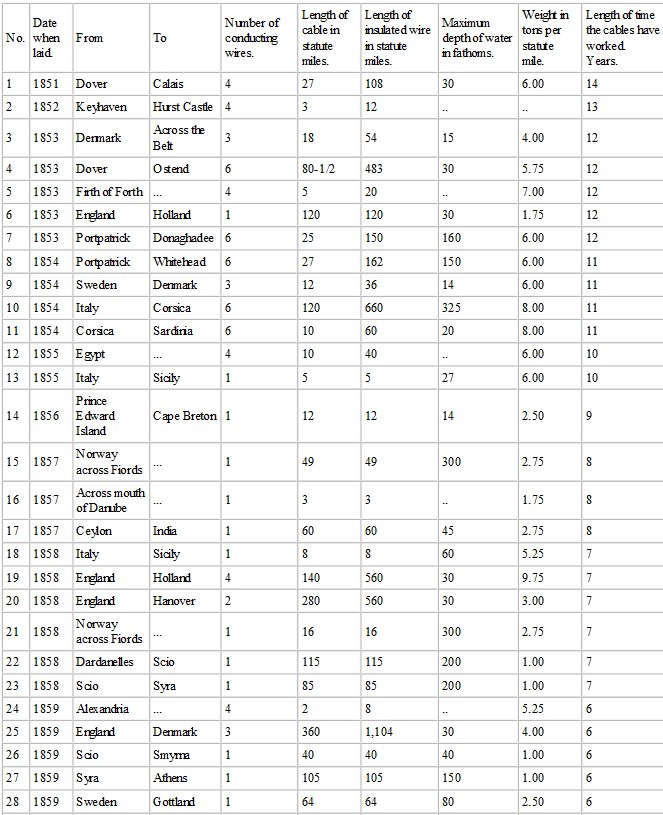
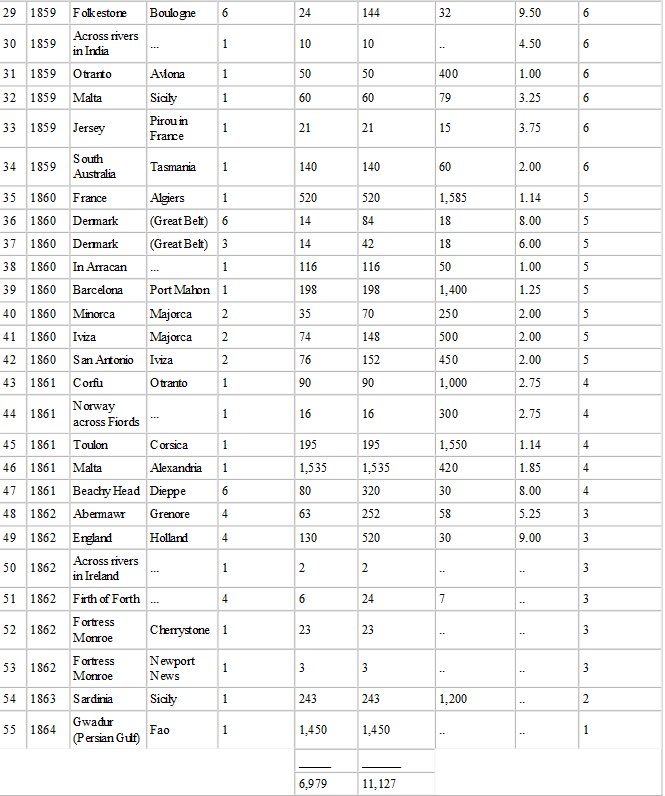
In addition to the above, there have been laid across American rivers, since 1854, 95 lines, in lengths of from 120 feet to two miles, and comprising from 120 feet to 6 miles of insulated wire each,—making an aggregate of 250 miles of subaqueous wire in operation on this continent, and a total of 6,979 miles of cable, and 11,127 miles of submarine wire in operation in all parts of the world.
Table II
Submarine Telegraph Cables which have been successful for some Time, but are not now working.
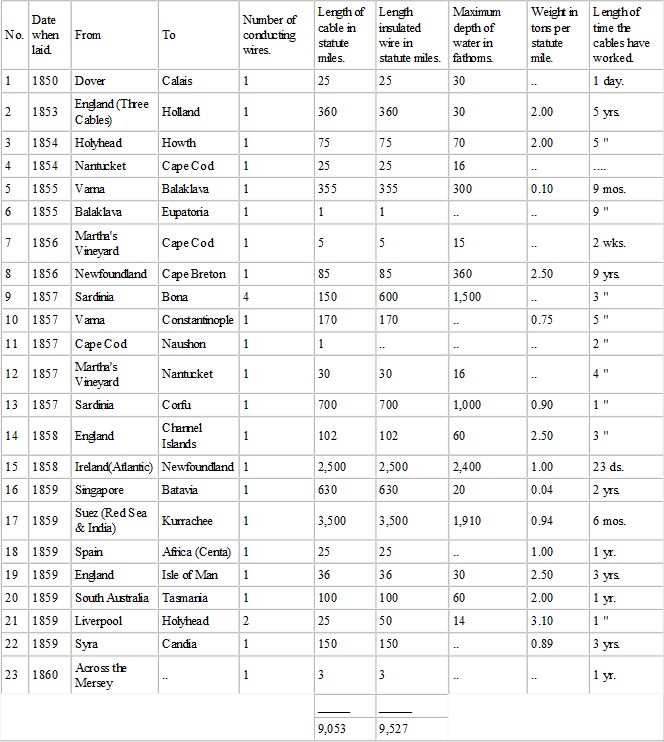
Table III
Submarine Telegraph Cables Which Are Total Failures.
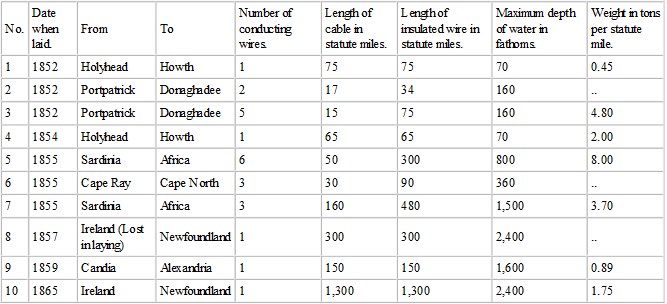
It will be seen from the above list of failures, that the great extension and success of submarine cables has been attained through many great failure,—among the most prominent being the old and new Atlantic, the Red Sea and India, (which was laid in five sections, that worked from six to nine months each, but was never in working order from end to end,) the Singapore and Batavia, and Sardinia and Corfu. None of these cable, with the exception of the new Atlantic, were tested under water after manufacture, and every one of them was covered with a sheathing of light iron wire, weighing in the aggregate only about fifteen hundred pounds per mile.
These two peculiarities are sufficient to account for every failure which has occurred, with the exception of the new Atlantic. No electrical test will show the presence of flaws in the insulating cover of a wire, unless water, or some other conductor, enters the flaws and establishes an electrical connection between the outside and inside of the cable. All cables now manufactured are tested under water before being laid.
Communication between the Ottoman capital and Western Europe passes through Vienna. From this city to Constantinople there are two distinct lines,—one passing by Semlin and Belgrade to Adrianople, the other by Toultcha, Kustendji, and Varna. There is a third line to Adrianople by Bucharest; and by the opening of the submarine line between Avlona and Otranto, in Italy, the Turkish telegraph service will be in direct communication with the West, without going through Servia or the Moldo-Wallachian Principalities.
Communication between Constantinople and India is maintained over the following route:—To Ismid, 55 miles; thence to Mudurli, 104 miles; thence to Angora, 111 miles; thence to Guzgat, 113 miles; thence to Sivas, 140 miles; Kharpoot, 178 miles; Diarbekir, 77 miles; Mardeen, 61 miles; Djezireh, 104 miles; Mosul, (Nineveh,) 91 miles; Kerkook, 114 miles; Bagdad, 189 miles. From Bagdad to Fao, at the mouth of the Shat-el-Arab, on the Persian Gulf, is 400 miles. From Fao to Kurrachee the submarine cable stretches along the bottom of the Persian Gulf for 1,450 miles; and thence are 500 miles of aërial line across a portion of British India to Bombay.
The accounts of the successful opening of this line tell of the astonishment of the savage Beloochees and Arabs along the Mekran coast at the marvel of a blue spark flashing for the Sahib to the Indus and back again in less time than it takes to smoke a hookah. At Gwadur, no sooner was the cable landed than the people of the surrounding country flocked down to hear and talk of the Feringhee witchcraft. Chiefs of the Beloochees, Muscatees, and Heratees, with their retainers, trod upon each other's toes in their eagerness to see it work. Gwadur has given up the idea that Mahomet taught everything that could be known, and now sits upon the carpet of astonishment and chews the betel-nut of meditation.



